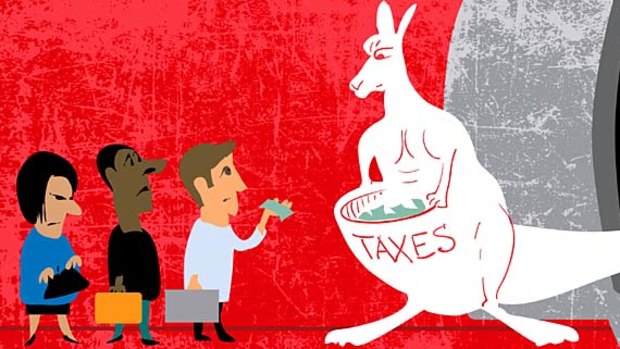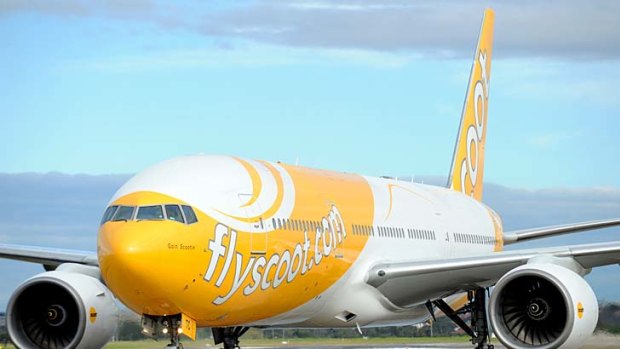By Jane E. Fraser

Illustration: michaelmucci.com
Airlines charge very different prices for the same routes, often for reasons that are far from apparent to the average passenger.
I was contacted by a reader wanting to know how the new no-frills airline, Scoot, can charge less for a fare to Singapore than he pays in taxes and charges on Qantas.
The reader noted that regardless of whether he purchases a ticket or uses his frequent-flyer points to acquire one, he always pays a set impost level, which amounts to more than $450 on a return economy-class ticket to Singapore.
Yet Scoot, which has just launched low-cost flights between Sydney and Singapore, has been selling fares from as little as $88 one way - less than the cost of the "taxes and charges" component collected by the national carrier.
How is this possible, he asks.
Is Scoot paying the same taxes and charges as Qantas?
Clearly, the lead-in airfare is not the only airfare on offer.
Is Scoot deliberately running its flights at a loss?
Or does Qantas have a "profit component" or some other factor built into its taxes and charges?
Taxes and charges have long been a source of frustration for airline passengers - along with the travel industry - not only because they add up to such large amounts but because it is hard to make head or tail of them.

How can Scoot offer $88 flights to Singapore when that is less than Qantas's taxes and charges on the same route?Credit: James Morgan
The Qantas website was little help, with a mock search for a return flight to Singapore bringing up a total fare of $1130 but limited explanation of its composition.
The available "price breakdown" only showed that the fare was $659 and the "taxes, fees and carriers [sic] charges" amounted to $471.46, meaning the fare represented less than 60 per cent of the total price.
Webjet was more transparent, with a similar search on its site bringing up a fare with the option to view a complete breakdown of its components.
Part of the answer to the reader's mystery soon became apparent, with the breakdown of taxes and charges including a fuel surcharge of $350 levied by Qantas.
Most international airlines are now charging fuel surcharges because of the high price of oil, and by recouping fuel costs through a surcharge rather than just increasing the price of the fare, they have drastically bumped up the taxes and charges component of air tickets. (The move also allows airlines to charge something for frequent flyer seats, as the fuel costs are a surcharge rather than part of the fare being redeemed.)
Left over after the fuel surcharge, credit card fees and Webjet's booking fees were removed from the fare to Singapore, was about $120 worth of other taxes and charges.
Given that these are all non-avoidable government and airport charges and therefore paid by all passengers on all airlines, the reader's question is a valid one.
With taxes and charges taken into account, Scoot would be left with only about $50 in total from a passenger making a return flight between Sydney and Singapore at $88 each way.
The chief executive of Scoot, Campbell Wilson, says lead-in fares are "only one element of the airline's revenue stream". "Clearly, the lead-in airfare is not the only airfare on offer," Wilson says.
However, he says Scoot's low cost base allows it to offer substantially cheaper pricing than "legacy airlines" that carry accrued costs and inefficiencies.
Scoot enjoys significant savings through initiatives such as fitting more seats per row, outsourcing services to other providers and using the latest technology rather than legacy systems.
Getting back to the taxes and other charges, it is quite a challenge to work out exactly what you're paying for, even when you have received a breakdown.
The biggest charge is the passenger movement charge, which could otherwise be called Australia's departure tax.
This amount, now $55 a passenger, is ostensibly to cover the cost of border services, but there is debate among interested parties about where the money actually goes (see "Big tax grab?").
According to the Tourism and Transport Forum, Australia now has the second-highest departure tax in the developed world (the highest for short-haul routes), with only Britain charging more.
There are also several charges collected by airports, to cover facilities such as runways and terminal buildings, with a "safety and security" charge to pay for security services.
Flight test: Scoot from Sydney to Singapore
Big tax grab?
The passenger movement charge (PMC) paid by travellers leaving Australia collects more than double the amount needed for primary border protection services such as customs and quarantine, the Tourism and Transport Forum says.
The PMC has been increased from $47 to $55 an international passenger, with the government arguing it is spending money on a wide range of tourism industry services and promotion.
The increase comes as the government cuts funds for processing passengers, though their numbers are expected to rise.
Sign up for the Traveller newsletter
The latest travel news, tips and inspiration delivered to your inbox. Sign up now.